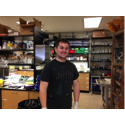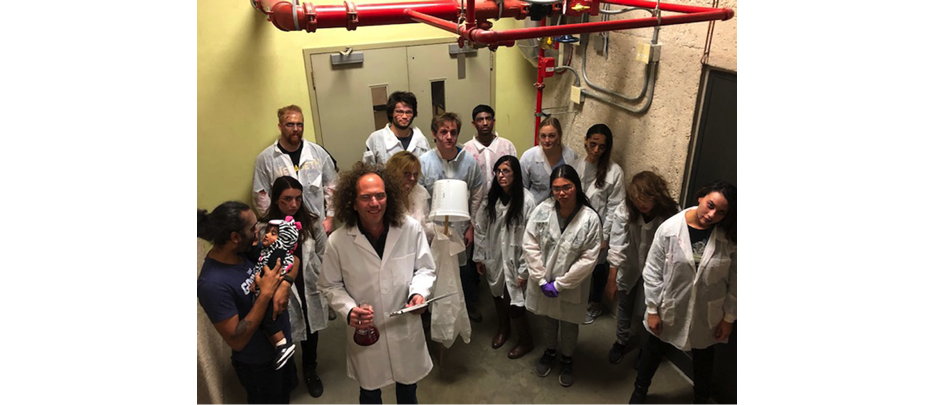Eberhart Lab
University of Texas at Austin

Johann Eberhart PI
I obtained my B.A. degrees in Biology and Psychology at Bethel College in North Newton, KS. While I had a thirst for knowledge in all areas of Biology and Psychology, it was my Developmental Biology class that inspired me the most. “How is a complex organism generated from a single cell” is a fascinating question that has continually driven my research.
For my M.S. and Ph.D research, I explored the mechanisms that govern development of the nervous system. At Wichita State University, where I obtained my M.S. under the mentorship of John Schmidt, I analyzed the role of members of the cadherin family of cell-cell adhesion molecules in the development of the murine brain. While a Ph.D. student at the University of Missouri at Columbia working in Catherine Krull’s laboratory, I determined the roles of Eph/ephrin signaling molecules in motor axon guidance in the chicken hind limb. Through my graduate training I gained a deep appreciation of the signaling and cell behaviors involved in development.
As I moved on to my post-doc I wanted to combine genetics with imaging to finely dissect the effects of signaling interactions on the cellular behaviors underlying morphogenesis. I entered Charles Kimmel’s lab where a focus of my work was directly imaging neural crest cell behaviors in living wild-type and mutant zebrafish embryos. This direct imaging of morphogenesis provides deep understanding of both normal development and how development can go awry in disease.
In my lab, we continue to analyze crest cell behavior in zebrafish. Looking not only into the signaling pathways involved in cell behaviors but also the genetic and environmental modifiers mediating these behaviors.
Mary Swartz
My background in science is quite varied. I began my career as a horticulturist.Continued my training in biology while working towards a Master of Science degree, addressing population level questions in Helianthus, (sunflower) species under the mentor ship of Karen Brown and Art Youngman at Wichita State University. With short stints as a fisheries biologist for the state of Kansas and a soils technician for the United States Forest Service, I rounded out my pre-developmental biology career.
I began my developmental biology training in the laboratory of Dr. Catherine Krull, where I was a research assistant for four years. While in her labratory I studied how EphA4-ephrinA5 interactions influence muscle precurser cell migration in the avian forelimb.
For the next six years I was a research assistant in Dr. Charles Kimmel’s labratory. My primary focus was to examine the role that mef2ca plays in patterning crainial neural crest specifically those that make up the jaw and jaw support of the zebrafish.
Currently I am a research associate in Dr. Johann Eberhart’s laboratory. I will be examining the genetic hierarchies that sculpt the palatal skeleton.
My interest in science developed during my undergraduate career, where I worked in the Sewanee Herbarium and Landscape Analysis Lab under the guidance of Dr. Jon Evans at the University of the South (Sewanee) in Sewanee, TN. My main contributions were in the development of the Domain Flora Project. Since the Domain Flora Project was launched in 1995, the Sewanee Herbarium has worked to catalog all of the vascular plant species on the Domain (the university's 13,000-acre landholdings). Most of my undergraduate study was dedicated to assisting the herbarium staff in the preparation of the Vascular Flora of the Domain. After graduating with a B.S. in biology from Sewanee, I worked as a lab technician in Dr. Daniel Promislow's lab at the University of Georgia. It was here that I gained a greater interest in genetics, studying the effects of aging on biological networks in fruit flies. In 2012, I entered the cell and molecular iCMB graduate program at the University of Texas at Austin. Although I was initially unsure of the lab I wanted to join, I have always had a particular interest in research with implications on human disease; and it was this interest that led me to the Eberhart lab. The Eberhart lab studies the genetic mechanisms underlying craniofacial defects in Fetal Alcohol Spectrum Disorder (FASD). I recently chose the Eberhart lab as my permanent home and will be examining 1) the interaction between ethanol and members of the planar cell polarity (PCP) pathway and 2) whether ethanol-sensitive miRNAs modulate at least part of this pathway.
Alfire Sidik


Desirè Buckley
My interest in science initiated after being hospitalized for kidney failure as a young child, and instantly, I wanted to pursue medicine. However, it was not until college that I experienced my first formal research venture, and ultimately confirmed my passion for scientific research.
As an undergraduate assistant in Dr. Christian Lorson's lab at the University of Missouri, I utilized a mouse model of spinal muscular atrophy, a neurodegenerative disease, to determine if muscle atrophy contributes to disease pathogenesis (Rindt and Buckley et al., Neuromuscular Disorders 22 (2012) 277–285). This served as my introduction to neurobiology, and helped refine my research interests prior to graduate school. For my doctoral degree, I continued studying at the University of Missouri under the mentorship of Dr. Samuel T. Waters, where I functionally characterized the Gbx1 transcription factor in formation of mouse hindlimb locomotor patterning during embryogenesis (Buckley et al., PLos ONE 8 (2013) 1-16). Through this work, I found my place as a developmental neuroscientist. Following my Ph.D., I sought to incorporate my original medical interests from childhood with my newly developed expertise and passion for developmental neurobiology from my research training.
Currently I am a postdoctoral fellow in the Eberhart lab exploring how gene-ethanol interactions give rise to neural defects associated with FASD. I utilize ethanol-sensitive zebrafish mutants combined with transgenics to perform in depth analyses of neural development, including: 1) examining how gene-ethanol interactions disrupt neurogenesis and 2) determining the extent to which ethanol alters neuronal migration.

Yohaan Fernandes
Issues centered on human development, behavior and disabilities have always interested me. As such I obtained a Hons. B. Sc. specializing in Human Exceptionality and Learning from the University of Toronto, Canada. The undergraduate thesis requirement of my degree connected me to my mentor Dr. Robert Gerlai and laid the foundation of my graduate research. Over the course of my graduate studies I obtained an M.A in Psychology and a Ph.D. in Cell and System Biology from the University of Toronto with Dr. Gerlai.
The beginning of my graduate studies focused on demonstrating the viability of using zebrafish to model the behavioral deficits common in individuals with fetal alcohol spectrum disorder (FASD). I was able to show that embryonic alcohol exposure impaired social behavior, learning and memory in adult zebrafish. Towards the end of my graduate training I became interested in understanding the mechanisms responsible for the behavioral and/or cognitive deficits caused by embryonic alcohol exposure. This interest led me to Dr. Eberhart.
In Dr. Eberhart's lab my goal is to examine the role genes and the environment play in the development of complex behavior and their underlying neurotransmitter systems. My research has two aims. Aim1: Characterize gene-ethanol interactions that result in neural and behavioral defects. Aim 2: Determine the role that alcohol sensitive neurotransmitters play in social behavior.

Ranjeet Kar
I am a homegrown Longhorn, having earned a B.S. in Biochemistry and a B.S. in Public Health here at the University of Texas. As an undergraduate, I worked in Dr. Hans Hofmann's lab, where I used bioinformatics techniques to explore the evolution of monogamous behavior in diverse taxa. This research project motivated me to pursue a graduate degree so that I could further understand how genomics approaches are used to answer biological questions. I remained at UT Austin for graduate school through the Cell and Molecular Biology program. After a year of rotations, I joined the Eberhart lab. Under the co-advisement of Dr. Eberhart and Dr. Vishy Iyer, I will use a combination of experimental genetics and bioinformatics techniques to explore the Gata3 regulatory network.

Tim Kuka
I started research as an undergraduate in the Largaespada lab at the University of Minnesota studying the genetics of hepatocellular carcinoma. My initial interest in biology was in genetics, but my time spent studying cancer introduced me to the field of cell communication. Specifically, I was interested in how a cell interpreted the many stimuli in its environment to make cell fate, growth, and survival decisions. Upon graduation, I remained in the lab as a staff scientist for one year before joining the CMB program and eventually the Eberhart lab. My work in the lab has focused on how cells in the developing face make fate decisions based on signals from neighboring cells and the environment, specifically ethanol exposure. My primary projects are on members of the low-density lipoprotein receptor related proteins, a family of receptors and co-receptors involved in many cell signaling pathways. I am also studying the role of receptor-mediated endocytosis on how these signals are interpreted.


Josh Everson
I received my B.S. in Molecular Biology at the University of Wisconsin – Madison. During my studies I began working in the lab of Dr. Wade Bushman, a urological surgeon, where I examined the function of a critical regulator of development and cancer called Sonic Hedgehog in the prostate. Following graduation, I moved down to North Carolina where I worked for the eminent embryologist Dr. Kathy Sulik at UNC – Chapel Hill, studying the interplay between Sonic Hedgehog pathway mutations and prenatal alcohol exposure using mouse models.
I became enamored with genetics and developmental biology—the enigmatic complex and intertwining signaling transduction cascades that drive cell type specification through differential gene expression to transform a trilaminar disc of cells into a near-complete body form in only a matter of weeks for humans or days for mice. Equally amazing is that these events follow strict timelines, which define so-called critical periods/windows of development—points of development where a cellular or molecular event must occur or it never will, which can lead to devastating birth defects. This is the concept that drove my interests to toxicology, since in utero exposure to environmental agents at the right time can disrupt these normal genetic programs and cause birth defects. But critically, unlike genetic mutations, each of us has the ability to control and avoid environmental exposures—provided we know what to avoid and when.
I therefore pursued a PhD in molecular and environmental toxicology at UW-Madison, where I studied the genetic and environmental underpinnings of cleft lip/palate and a common brain malformation known as holoprosencephaly under Dr. Rob Lipinski.
With my PhD completed, I have now returned to examining the effects of embryonic alcohol exposure, since it is arguably most common environmental cause of human birth defects. I moved down to the University of Texas at Austin where I now work as a post-doc for Dr. Johann Eberhart using a powerful and relatively new model organism—the zebrafish—which provides high-throughput screening capacities. The goal of this work is to identify genetic mutations or common environmental agents to which humans are frequently exposed that can either increase or decrease the embryo's susceptibility to ethanol's effects. Ultimately this work will aid our ability to (1) identify human populations with heightened risk to ethanol-induced birth defects and (2) enable more comprehensive risk communication for environmental agents that pose a risk to developing embryos.

Scott Tucker
As an undergraduate at Western Michigan University, I studied in Dr. John Spitsbergen's neurobiology laboratory, examining the role of neurotrophic factors in the formation and survival of neuromuscular junctions. I obtained a M.S. at The Technion in Dr. Tali Haran's laboratory, investigating how the kinetics and thermodynamics of p53/DNA interactions determines its cellular function. Currently, I study the influence of genetics and the environment on the survival and migration of the neural crest, a multipotent stem cell population. The aim of my research is to identify and characterize genes that regulate neural crest susceptibility to, or resistance against, prenatal ethanol exposure. I am particularly interested in members of the mTOR pathway, which coordinate fundamental cellular processes with environmental inputs, like nutrients and growth factor signaling.


Hannah Kirby
I began research as an undergraduate student at the University of Texas at Austin in Dr. Eberhart's lab. I conducted research with Dr. Alfire Sidik, and we studied the interaction of ethanol and members of the planar cell polarity pathway. I have recently graduated with a B.S. of human biology, and I am now a Research Associate of Eberhart Lab, where I will continue research.

Rayna Mazumdar
I received my B.S.A in Biology from the University of Texas at Austin where I had the pleasure of working in the Eberhart lab under my mentor Johann Eberhart. My experience in the lab has consisted of independently running a reverse genetic screen for multiple genetic lines. Specifically, I have been screening mutants with mutations in putative susceptibility genes (nnt, fam65b, dynlt1, and wt1a) for heightened sensitivity to ethanol-induced defects. I dose wildtype, heterozygous, or mutant zebrafish embryos with ethanol and other drugs, as well as control and test whether fish with mutant alleles exhibit more severe malformations than their wild-type siblings. I characterize aberrant phenotypes by staining each embryo's bone and cartilage and scoring the severity of defects.
Moving forward, I will continue my work on genetic screens as well as begin new projects with the ultimate goal of characterizing ethanol sensitivity within susceptible lines.
Cadianna Garcia
My research journey began when I joined the Miranda lab in the Department of Neuroscience and Experimental Therapeutics at Texas A&M University. There I studied the teratogenic effects of maternal alcohol consumption using neural stem cells and worked to identify the role of microRNA in regulation and development of the brain. Dr. Miranda encouraged me to pursue my M.S. in Biotechnology, which I completed at the University of Houston-Clear Lake. While obtaining my M.S., I joined a lab at MD Anderson with a research focus in identifying the mechanism of mucin secretion using a mouse model. After my graduate experience, I decided to move to Austin, TX where I currently work as a Research Associate under Dr. Eberhart. I am researching the effects of embryonic alcohol exposure on the craniofacial skeleton using a forward genetic screen.
